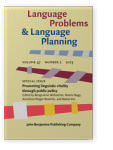Visibility and (re)vitalization
The case of Asturian language in Asturias, Spain
Recent sociolinguistic research has shown the impact of public use of language expressions on people’s attitudes
towards their language and how language can be susceptible to its environments. In this regard, the linguistic landscape
(henceforth, LL) of a community helps sociolinguists to examine and decipher the power relationships of languages
used in any bi/multilingual community. The presence or absence of a language in the public space carries a message that directly
and indirectly reveals its centrality versus its marginality in the community.
The present study analyzes language (in)visibility in the LL of three major cities (Oviedo/Uviéu,
Gijón/Xixón and Avilés) of Asturias, Spain, where Spanish is the majority language and Asturian is the regional language. The
empirical data provided in this article are based on an exemplary selection of publicly visible language policies and a survey
conducted by the authors on language attitudes. The results of the analysis suggest a mismatch between language policy and
language use in the region and a lack of prestige bestowed upon the Asturian language.
Article outline
- 1.Introduction
- 2.Literature review
- 3.Asturian, an endangered language
- 4.Methodology
- 5.Results and data discussion
- 6.Conclusions
- Notes
-
References
